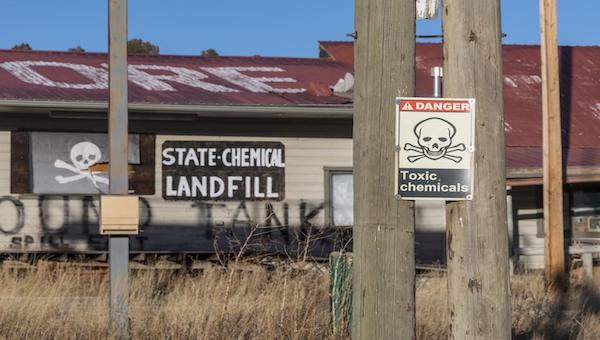 Site of leaking underground gasoline tanks, near the Mesa Verde National Park, in Colorado, USA. (Credit: Keystone/Science Photo Library/Jim West)
Site of leaking underground gasoline tanks, near the Mesa Verde National Park, in Colorado, USA. (Credit: Keystone/Science Photo Library/Jim West)
CATCHING SIGHT OF THE INVISIBLE CHEMICALS CRISIS
BY: MICHELLE LANGRANDSITE: GENEVA SOLUTIONS
TRENDING
Activism
Belief
Big Pharma
Conspiracy
Cult
Culture
Economy
Education
Entertainment
Environment
Global
Government
Health
Hi Tech
Politics
Prophecy
Science
Social Climate
Universe
War
Chemicals are killing millions and threatening the world’s ecosystems, despite countries’ efforts to crack down on some of the worst offenders. Is it too late to avert what the UN has dubbed the third planetary crisis?
Pesticides, heavy metals, plastic additives, radioactive waste, and other toxic substances are flooding the water, land, and air. Nine million people die prematurely every year from toxic chemicals and pollution, according to a recent report by the UN special rapporteur on the environment, David Boyd, which he will present in two weeks at the UN Human Rights Council.
Scientists also revealed last month that the Earth’s threshold for pollutants has been breached, posing a serious threat to the natural world.
Countries have agreed to ban some of the most deadly substances in the last 30 years. In Europe, tougher rules on chemicals and heavy metals have entered into force in the last month and the Stockholm Convention in Geneva moved closer to globally banning the dangerous plastic additive UV-328.
However, thousands of chemicals have yet to be tested for their adverse effects and the world’s chemical watchdogs have only regulated a tiny fraction.
How we got here
Chemicals have been in our midst for thousands of years. Elemental sulphur is thought to be one of the first pesticides to be used 4,000 years ago in Mesopotamia. But it was not until the end of the 19th century that the chemicals industry started booming. Since 1950, the production of chemicals has increased five-fold, amounting today to 2.3bn tonnes.
And the chemicals industry is not showing signs of letting up. Global sales are expected to nearly double by 2030, from $3.47 trillion to $6.6 trillion, with China projected to account for half of it, according to a report by the UN Environment Programme.
Now there are roughly 350,000 different types of chemicals out on the market and only a tiny fraction has been tested for adverse effects on the environment or on humans.
“The global community does not have information on all of the chemicals that are being used, and in many cases, that includes data on the risks that they pose,” Giulia Carlini, senior attorney at the Center for International Environmental Law (CIEL), told Geneva Solutions.Chemicals can leak into the environment at different stages of production, from the extraction of raw materials to manufacturing processes, to household usage all the way to waste disposal and incineration.
Exposure to toxic substances such as particulate matter, asbestos, or arsenic kills roughly 750,000 workers every year, the document states, and lead, which has been known for causing neurological problems in children, is responsible for around one million deaths every year, according to Boyd’s report.
Until death (doesn’t) do us part
Since evidence of the effects of chemicals on human health and the environment started to snowball in the 1980s, a number of global environmental agreements have been struck between countries to deal with the most dangerous substances, such as the Minamata Convention on mercury or the Basel Convention on hazardous waste movement across borders.
One of the eldest siblings, the Stockholm Convention, has successfully banned 28 persistent organic pollutants – or POPs. Considered to be the worst of the worst, these “forever chemicals” don’t easily break down and can last for generations in the environment. They accumulate in the fatty tissue of living organisms, getting a free ride up the food chain. They cause health issues including cancer, birth defects, and reproductive disorders.
Among these are the infamous pesticide dichlorodiphenyltrichloroethane (DDT) and polychlorinated biphenyls (PCBs), which are used in transformers and other electrical equipment. Production of both DDT, which messes with the nervous system, and PCBs, which are carcinogenic, has sharply dropped since the 1960s with only a handful of countries still producing them.
On 20 January the Aarhus protocol on POPs toughened restrictions in 23 European countries, adding five new substances to its list of 16 banned chemicals. It was hailed by the UN Economic Commission for Europe (UNECE), which hosts the agreement, as “an important step in international efforts to address emissions of POPs to the atmosphere”.
POPs emissions in the Pan-European region have declined by 40 per cent to 85 per cent since 1990, according to the regional agency.
But countries, particularly the less developed ones, are still struggling to deal with POPs. “Some countries may need to apply new techniques, for example, for waste incineration that require investments or shifting processes, together with stricter monitoring of emissions, particularly in Eastern Europe, the Caucasus and Central Asia where, unfortunately, we don't have many ratifications yet. But we are working to promote these ratifications and build capacity,” Albena Karadjova, secretary of the Convention on Air Pollution, to which the Aarhus Protocol on POPs is attached, told Geneva Solutions.
A huge issue is funding. According to a report from the Stockholm Convention, $5bn would be needed over the next five years to deal with the few chemicals the agreement encompasses. “The big elephant in the room is that synthetic chemicals are not just falling from the trees. There’s an industry that is willingly producing them and profiting from them even if the product is toxic,” Carlini said.
“They might get sued but it's more profitable to continue polluting because the negative externalities are not fully taken into consideration.”
CIEL along with the International Pollutants Elimination Network (IPEN) have proposed a fee of 0.5 per cent of the revenue of the industry to be collected to bear the costs of treating and eliminating chemicals. They will bring this proposal to the UN Environment Assembly taking place at the end of February in Nairobi, where a resolution proposed by Switzerland will focus on funding the chemicals regulation framework.
What about the other 350,000 chemicals?
There are thousands of chemical substances but only a few dozen are part of agreements. Environmentalists argue that global regulations work too slowly. “So far, the approach to regulating chemicals has been to check a single substance to see if it's safe or not. This overlooks the reality that we are exposed to hundreds of chemicals every day from different sources,” Carlini said.
“In some countries, the industry puts products in the market, and they are restricted years later, after seeing the effects on the environment and on populations. And it can be decades and even generations before we see the impacts of daily exposure to endocrine-disrupting chemicals that affect our hormone system.”
The existing conventions generally have expert bodies that review the science around one particular substance put forward by the state members.
“Those that were known for years and whose toxicity is beyond doubt are already being banned. There are others that are probably less harmful or where opinions differ as to the toxicity. It depends on existing alternatives as well,” said Karadjova.
“There are a lot more substances out there and it is up to the parties to identify those that are most harmful – because they have different degrees of harm – and take action on them.”
The process can be long and take several years, and ultimately up to the countries to make the decision. “It’s always a political decision on how to balance the economy with health and environment,” said Carlini, citing the example of the Stockholm convention’s expert committee in charge of reviewing POPs.
Countries can apply for exemptions. For example, a government could say it needs more time to phase out production of a chemical because of their heavy dependence on the product or can ask that it be allowed in specific uses that it considers essential.
“Looking past the list of exemptions, one begins to wonder, are all of these chemicals important enough that they need to continue to be produced? Or is their use allowed because there is no alternative?” Carlini says.
Better safe than sorry
There are efforts underway to regulate chemicals more efficiently. The European Union, for example, has adopted very progressive legislation on chemicals that requires industry manufacturers to prove that the chemical is safe before it can be put in the market.
In 2020, the European Commission adopted a chemicals strategy for banning unessential per- and polyfluoroalkyl substances (PFAS) – a large family of chemicals used in leather coating, cleaning products, firefighting foam or non-stick cookware. It is currently revising its chemicals regulations to include this.
PFAs have been linked to cancer, liver damage and endocrine disruption, but only a handful of them have been banned. Today, virtually everyone has these long-lasting toxic substances in their body, according to experts. In his report released this week, UN expert David Boyd urged countries to ban PFAs altogether.
“If there is data that shows that a chemical is harmful, is it necessary to look at all the different subcategories of chemicals in the same group, or is it possible to take a precautionary approach?” said Carlini.
The EU, which is part of the Aarhus Protocol on POPs and the Stockholm Convention, has plans to bring this family approach to the agreements. Whether it will attract some other supporters remains to be seen.
Click 3 Dots Below to View Complete Sidebar


